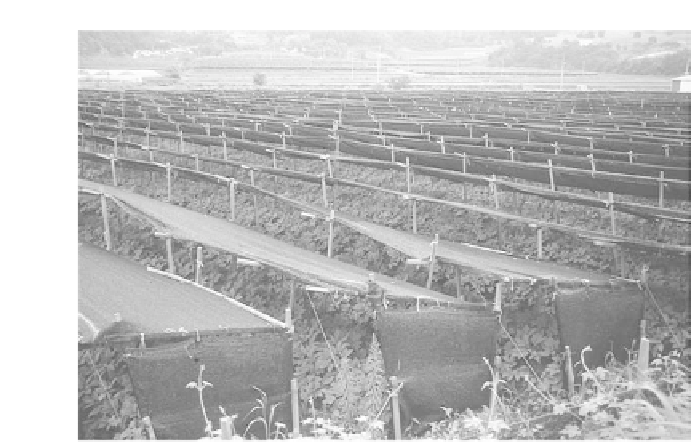Geography Reference
In-Depth Information
Figure 13-2
These are fields of ginseng outside Kumsan, the
main marketing center for ginseng in Korea. Here
the root is known as
insam
. The soil is a rich
mulch of chestnut or oak leaves, and the plants are
shaded with thatch or fiber mats. Once used, the
soil is not cultivated again for another 10 to 15
years. Ginseng, especially the red variety , has been
part of East Asian pharmacopoeia for centuries.
Photograph courtesy of B. A. Weightman.
and other types of market gardening. Kumsan is notable
for its ginseng production (Figure 13-2). Cattle are
raised on Cheju Island, where it is just warm enough to
grow oranges and pineapples. Greenhouse agriculture is
ubiquitous in South Korea.
South Korea is more urbanized than North Korea,
which has only one city over a million people. This is the
capital of Pyongyang with 2.6 million. The twin cities of
Hamhung-Hungnam contain fewer than a million peo-
ple. In the South, six cities have more than a million peo-
ple. The conurbation of Seoul and its port Inchon is the
largest, with a combined population of 18 million peo-
ple. Seoul, which means “capital,” has been Korea' s (now
South Korea' s) capital for 500 years.
The quintessential difference between North and
South is political. North Korea' is strict communist sys-
tem has produced a harsh landscape of rigidity and
poverty , isolated from all except China and Russia.
V ariation in South Korea' s government—from authori-
tarian to democracy—has produced a landscape of free
enterprise, modernization, and economic develop-
ment, which have raised the nation to the status of
Tiger in East Asia.
respectively . These three kingdoms vied for control of
the peninsula until the seventh century .
Aided by the Chinese, Silla was able to conquer
Paekche and Koguryo by 668 AD. T Trading centers devel-
oped in Kyongju, the capital, as well as in provincial
towns. Korean ships engaged in the region' s sea trade.
Buddhism (from China) was established as the state reli-
gion, and lavish temples and tombs were constructed
(Figure 13-3). Woodblock printing was developed for
the production of religious texts. From this time forward,
Korea had an important cultural influence on Japan, in-
cluding the introduction of Buddhism.
By 918, the kingdom of Koryo emerged in the cen-
tral region of the peninsula and overthrew Silla in 935.
Korea is the westernized version of Koryo. Buddhism re-
mained the state religion but Confucianism emerged as a
major force in government ethics and political structure.
Even today , Korea is considered the most Confucian of
all Asian nations. Check out its flag. Where do these
symbols originate?
In 1231, Mongol armies moved into the peninsula.
After 30 years of war, Koryo became a vassal state of
China' s Mongol Y uan Dynasty . Following the fall of the
Yi uan, Korea' s Yi Dynasty continued the tributary relation-
ship with China' s Ming Dynasty (Chapter 10).
The Yi moved their capital to Seoul on the Han River
and renamed their kingdom Chosun in 1392. Under Yi
rule, Confucianism replaced Buddhism as the state belief
system. The world' s first movable, metal type was devel-
oped. More importantly , a Korean lettering system was
developed in the fifteenth century . Known as
Hangul,
it
reduced dependency on Chinese characters and made lit-
eracy achievable for the general public.
HISTORICAL EVOLUTION
Archaeological evidence suggests that the Korean Penin-
sula was first settled 5,000 years ago when T Tungusic
tribes migrated to the area from Manchuria and north-
ern China. Koguryo, the first state, developed around
100 AD. The kingdoms of Paekche in the southwest and
Silla in the southeast emerged around 250 and 350 AD,

















Search WWH ::

Custom Search